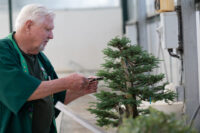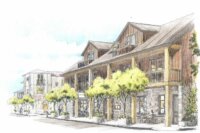The All-in-One almond tree (Prunus dulcis) is one of my favorite trees. I added three in my front yard just last year and I’m already treasuring them. If you like beautiful flowers, edibles, and water-wise landscaping make some space for a few of these botanical jewels.
Almond trees have many assets. First of all, they are drought tolerant. Yes, it is true that some high production almond growers use a lot of water on their trees. But they are aiming to feed the world. A home orchardist doesn’t need so much and can get a healthy crop of fruit with minimal water.
Almond trees also gift us with a glorious exhibit of five petaled white blossoms this time of year, mid February to early March. The blooms emerge before the new spring leaves so that every year for a few weeks almond trees dazzle us with a brilliant puffy white bouquet of loveliness. The scent of an almond blossom is divine.
Almond nuts are delicious. They are considered to be heart healthy, too, containing protein and the right kind of healthy fat. According to a 2014 Washington Post article almond consumption increased 220 percent over a nine-year time period. So join the crowd. Eat almonds.
There are many nice features to the All-In-One almond tree in particular. It is a genetically small tree that only grows to 15 feet. It won’t get out of hand in your back yard. If you want to maintain your almond tree at a smaller size, like 8 to 10-feet, it’s easy. I suggest pruning this tree once a year during the dormant season.
All-In-One almond is self-fruitful so it doesn’t need a cross-pollinator. The fruit is sweet and yummy. It ripens mid fall. The shells are relatively soft so they are easy to process before eating.
They don’t need a lot of care. Horticulturists recommend good rich soil for your best crop but they can grow just fine in leaner soils. I recommend that you add compost to the soil under your almond trees once a year. Good drainage is a must. If you have heavy soil amend it with compost and/or create a little mound before planting.
These trees are best for mild-winter climates like here in northern California. They only require 300-400 chill hours to set their fruit. Almond tree buds and blooms are perennially at risk for frost damage in February and March because they break out so early. But I’ve never lost a crop to frost in all the years I grew them in Kenwood.
Add some joy to your garden. Plant an All-in-One almond tree.






Great info on almond trees👍